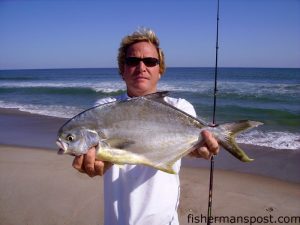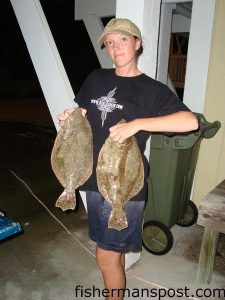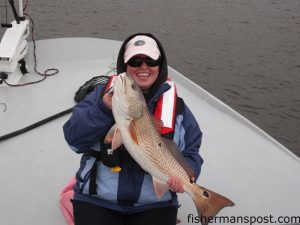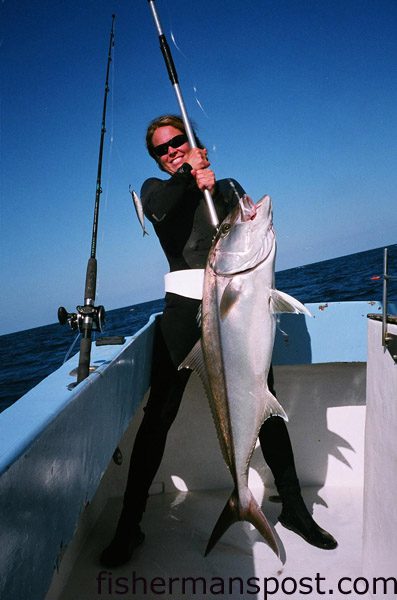Carolina Beach Winter 2010

Dr. Michael Durako and Corey Durako with a sailfish Michael caught and released near the Same Ol' on a black/purple trolling lure while fishing on the "Beagle."
Wes, of Island Tackle and Hardware, reports that local anglers have been catching big numbers of speckled trout in the Carolina Beach boat basin. There’s also been a good trout bite in Carolina Beach Inlet and at many spots throughout the Cape Fear River. Live shrimp are producing the most consistent action with the specks, but anglers are also putting together some nice catches on artificials like D.O.A. shrimp, and MirrOlure TT’s, TTR’s, MR17’s, and others.
The trout bite should continue through December and into the New Year, barring any extreme winter weather.
Surf fishermen are putting together decent catches of whiting while baiting up with shrimp, and a few flounder are feeding in the breakers as well.

Kevin Blake, of Kure Beach, with a 3.2 lb. pompano he hooked on shrimp in the Fort Fisher surf.
False albacore are chasing bait from the beaches out to nearshore structure. Anglers can hook up with the speedy battlers while casting Stingsilvers and other metal baits at the breaking schools of fish.
Offshore, anglers are still easily putting together limits of gag grouper at bottom structure 20-30 miles off the inlet, with some red grouper mixed in on the offshore side of that range. Jigging lures and bottom rigs baited with cigar minnows, live baits, cut baits, and more will attract attention from the grouper and other tasty bottom dwellers like sea bass, triggerfish, and more. The grouper bite should also remain consistent until the fishery is closed on January 1st.

Katie Barrier, from Salisbury, NC, with a pair of flounder she hooked from the beach at Fort Fisher while fishing with her husband Tim.
King mackerel have moved out to the 25 mile range, and they should continue to push offshore as the water cools down over the course of the month. Anglers chasing the kings seem to have had their best luck to the south of the area recently. While live baits are getting harder to come by, the cooler weather kings will readily take dead baits like cigar minnows or lures like Drone Spoons.
Boats making the run to the Gulf Stream have had some action with sailfish and wahoo over the past few weeks. The bite’s been much more consistent around the Same Ol’ than it has at other area spots like the Steeples. Anglers making the run to the blue water can hook up while trolling ballyhoo under skirted lures or dragging an all lure spread made up of Black Barts or other baits a little bit faster to cover more ground.

Hannay Young, of Belmont, NC, with a 31", 15 lb. red drum she hooked on a swimbait in Buzzard's Bay while fishing with Capt. Robert Schoonmaker of Carolina Explorer Charters out of Carolina Beach.
The wahoo should stay in the area and on the feed for much of the winter, and anglers willing to run a bit further into warmer water may be able to find some dolphin action in the cooler months as well.
Jeff, of Seahawk Inshore Fishing Charters, reports that the speckled trout and red drum bite is going strong in the Cape Fear River.
The reds are feeding in the creeks off the lower river. Some of the creeks are so small a flats skiff can barely make it to where the fish are. The shallow confines of the narrow creeks are creating excellent sight-casting opportunities for the reds, with single fish, pods of a few, and small schools all feeding in the skinny water. Anglers can tempt the fish to bite soft plastic baits like Redfish Magic Glass Minnows and Gulps, or cast live baits like mud minnows and shrimp on jigheads to hook up. Flies have also proven effective on the backwater reds lately.
Slightly deeper water in the lower river is also producing good numbers of fish for anglers blind casting with artificials.

Capt. Savannah Batson with a 60 lb. amberjack she hooked on a cigar minnow while fishing some bottom structure 40 miles off Carolina Beach Inlet. The jack fell for a cigar minnow.
The specks are feeding in the deeper creeks, around the grass islands, and on oyster bars and other rocky structure in the lower river. Billy Bay Halo shrimp, other soft plastic baits, and live shrimp are all producing action with the specks.
Bruce, of Flat Dawg Charters, reports that the trout bite is a bit slower than it was last year at this time, but anglers are still finding some hungry specks in the lower Cape Fear. Most of the fish are decent-sized (2-3 lbs.), but they’re not around in the numbers they were last fall. Live shrimp and imitations like D.O.A.’s are attracting attention from the trout, and strangely, some days the imitation shrimp are outfishing the real thing.
Anglers are catching decent numbers of smaller trout around the boat basin.
The trout should continue to bite into January and February.
Decent numbers of smaller red drum (most 16-20”) are mixed in with the trout, and they’re falling for the same baits.
Brad, of Fish Spanker Charters, reports that the bottom fishing’s been good in the 30-45 mile range lately. Dropping cigar minnows, squid, cut and live baits to structure in that range has been attracting attention from red, gag, and scamp groupers, along with smaller bottom feeders like pinkies, grunts, sea bass, triggerfish, and more.





